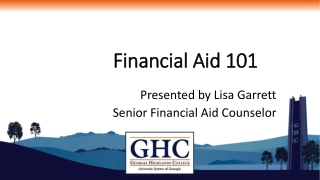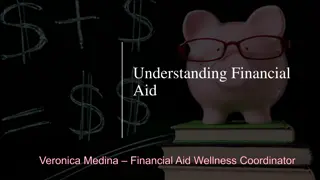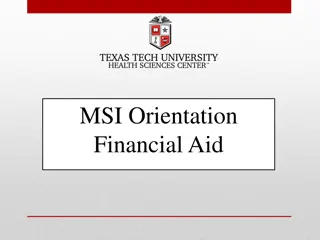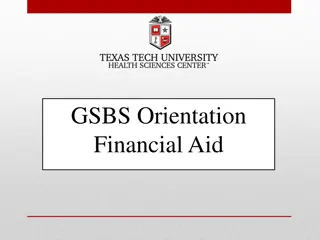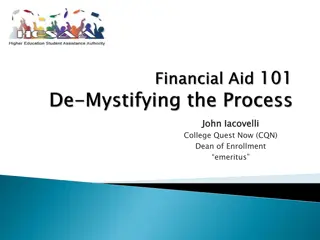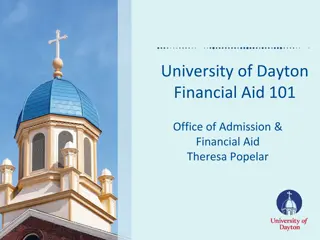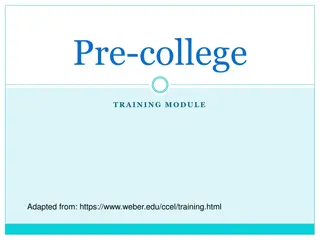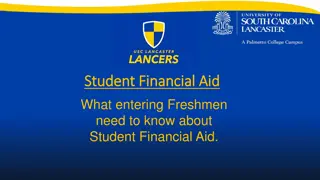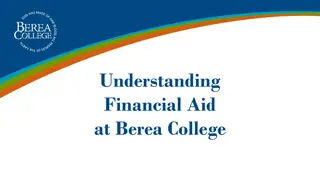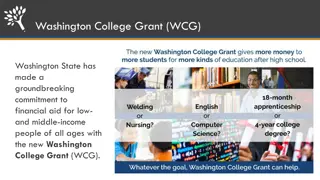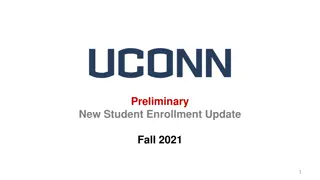Understanding the Impact of Losing Financial Aid on College Students
This study explores the consequences of losing financial aid on college students' academic pursuits and work decisions. The research focuses on the Tennessee HOPE scholarship and its effects on students' enrollment, credit accumulation, and major choice. The findings shed light on the challenges students face when balancing financial aid requirements with academic progress and employment opportunities.
Download Presentation

Please find below an Image/Link to download the presentation.
The content on the website is provided AS IS for your information and personal use only. It may not be sold, licensed, or shared on other websites without obtaining consent from the author. Download presentation by click this link. If you encounter any issues during the download, it is possible that the publisher has removed the file from their server.
E N D
Presentation Transcript
1 LOSING HOPE Financial Aid and the Line Between College and Work February 2013 Celeste K. Carruthers and Umut Ozek University of Tennessee and AIR/CALDER
2 Essential Questions Financial aid has been shown to increase college enrollment, persistence, and graduation1 Caveat: results are not universal2 Why is financial aid important for students? Why do students work so hard to avoid losing aid? 3 Non-pecuniary loss aversion? Financial need? 1 Dynarski 2000,2003; Deming & Dynarski 2009; Scott-Clayton 2011; Castleman & Long 2012 2 Hansen 1983; Cohodes & Goodman 2012; Sjoquist & Winters 2012 3 Cornwell et al. 2005; Scott-Clayton 2011
3 Contributions To date, we know that students who lose Georgia's HOPE accumulate fewer credits and receive fewer degrees (Henry et al. 2004) and tend to be concentrated in more technical majors (Dee & Jackson 1999). We provide the first causal evidence of students' college/work substitution patterns in the wake of losing financial aid. Preview: less college, more work Beyond the scope of this paper: normative statements on optimal scholarship retention policies.
4 The Tennessee HOPE scholarship Financed by the state lottery First available to fall 2004 freshman (and some sophomores) Up to $4,000/year grant for four-year students, $2,000 for two-year students Low eligibility threshold and (comparatively) high renewal threshold. Renewed with continuous enrollment, GPA of 2.75 after 24 hours, 3.0 after 48, 72, and 96 hours. About 1/2 of HOPE scholars lose their scholarship midway through college.
5 Data Administrative records for 2003-2006 entering cohorts in Tennessee two-year and four-year institutions, followed through fall 2008. Scholarship status, credits attempted per term, major(s), college GPA, demographics, distance from permanent address. Merged with FAFSA and ACT records for income and ACT controls. Merged with quarterly earnings data for every quarter (enrolled or not), 2003-2008. Merged with full-time undergraduate tuition and fees (IPEDS).
6 Descriptive Statistics 4-year students 14.2 (2.7) 0.17 0.70 2-year students 11.4 (3.9) 0.12 0.78 All 13.2 (3.4) 0.15 0.73 Credit load (attempted credits this term) Different major from last term Any earnings while enrolled (half-year) Earnings while enrolled (half-year, thousands, 2005$) 2.6 (3.2) 2.2 (2.9) 3.4 (3.4) Exiting college: working but not enrolled next term Undeclared major Student-years Students 0.12 0.23 584,925 116,440 0.06 0.30 369,044 73,816 0.22 0.13 215,881 67,823 Standard deviations in parentheses below continuous variable means
7 Descriptive Statistics All 0.19 1.39 (1.82) 2.20 (1.32) 0.05 4.04 (1.33) 0.44 0.16 0.78 0.47 0.08 584,925 116,440 4-year students 0.21 1.95 (1.98) 2.38 (1.26) 0.05 4.98 (0.60) 0.45 0.17 0.77 0.44 0.05 369,044 73,816 2-year students 0.14 0.43 (0.88) 1.90 (1.36) 0.06 2.42 (0.20) 0.43 0.15 0.80 0.52 0.14 215,881 67,823 Lost HOPE Scholarship value (in thousands) Cumulative GPA Missing GPA Tuition and fees (000s) Male Black White Family income $<$ 60,000 Missing family income Student-years Students Standard deviations in parentheses below continuous variable means
8 Empirical Strategy ??? = 0+ ?1(???? ?????) + 1? ?01 ???????? + 2? ?01 ??????? + ??????+ ?+ ?+ ???? + ?? 1(losthopeit) equal to one in semesters after HOPE loss. 1(t-t0)*1(beforeit) + 2(t-t0)*1(afterit) - local linear function of time until/since HOPE loss t*GPAit- college GPA, effect allowed to vary by t i, t- individual and semester sequence FE Zit - time-varying student and institution controls, linear time trend.
9 Empirical Strategy ??? = 0+ ????+ 1? ?01 ???????? + 2? ?01 ??????? + ??????+ ?+ ?+ ???? + ?? Hit - value of HOPE scholarship in 2005$.
10 Identifying Variation in HOPE 2004-2006 cohorts Deviations from mean HOPE status or value, across and within students. Within-student, across t. Within-semester sequence, across i Within-student variation is from the failure to renew HOPE. 2003 cohort Deviations from mean HOPE status or value, across and within students. This cohort was eligible to gain HOPE in 2004, then held to renewal standards thereafter.
11 Internal Validity Challenges Students who lose HOPE are of lower ability. i controls for this class of heterogeneity. Students about to lose HOPE are on Yit trajectories that confound treatment with other factors. 1(t-t0)*1(beforeit) + 2(t-t0)*1(afterit) controls for pre-loss and post- loss trends common to students who lose the scholarship. Typically, GPA starts low and climbs just before HOPE loss.
12 College GPA before and after HOPE loss
13 Credits attempted before and after HOPE loss (regression-adjusted)
14 Exit rates before and after HOPE loss (regression-adjusted)
15 Results 2004-2006 cohorts (1) (2) (3) (4) Outcome Credits this term Changed major (0,1) Lost HOPE (0,1) HOPE value (000s) Four-year public (0,1) Terms until loss (negative) Terms since loss Tuition and fees (000s) Adjusted R2 -0.996*** (0.025) -0.006** (0.003) 0.684*** (0.007) 0.408*** (0.107) 0.390*** (0.012) 0.167*** (0.009) 0.772*** (0.040) 0.18 0.012*** (0.001) 0.088*** (0.010) 0.014*** (0.001) 0.002* (0.001) -0.009** (0.004) 0.11 1.573*** (0.117) 0.149*** (0.012) 0.067*** (0.009) 0.734*** (0.045) 0.13 0.109*** (0.010) 0.007*** (0.001) -0.001 (0.001) -0.010** (0.004) 0.11 Nit = 421,615 student-years. Cluster-robust standard errors in parentheses
16 The impact of HOPE loss versus an equivalent tuition increase on attempted credits
17 Results 2004-2006 cohorts (1) (2) (3) (4) Outcome Any earnings this term (0,1) Earnings (000s) Lost HOPE (0,1) HOPE value (000s) Terms until loss (negative) Terms since loss Adjusted R2 -0.006* (0.003) 0.170*** (0.019) 0.001* (0.001) 0.005*** (0.001) 0.002 (0.001) 0.02 -0.027*** (0.004) 0.042*** (0.008) 0.032** (0.012) 0.09 0.005*** (0.002) 0.002 (0.001) 0.02 0.022** (0.009) 0.112 (0.073) 0.09 Nit = 421,615 student-years. Cluster-robust standard errors in parentheses
18 Results 2004-2006 cohorts (1) (2) (3) Outcome Undeclared major (0,1) 0.054*** (0.003) Work but no college next term, and no degree (0,1) 0.070*** (0.002) Lost HOPE (0,1) HOPE value (000s) Terms until loss (negative) -0.017*** (4.5E-05) -0.029*** (0.001 -0.021*** (0.002) -0.034*** (0.001) Terms since loss Adjusted R2 -0.002* (0.001) 0.15 -0.002*** (0.001) 0.16 0.001 (0.001) 0.16 Nit = 421,615 student-years. Cluster-robust standard errors in parentheses
19 Results 2003 cohort (1) (2) (3) (4) Outcome Credits this term 0.334*** (0.012) -0.040*** (0.012) 0.123*** (0.018) 0.11 Changed major (0,1) 0.013*** (0.001) 0.009*** (0.001) -0.003* (0.002) 0.11 Earnings (000s) Leaving college (0,1) -0.013*** (0.001) -0.017*** (0.001) -0.003*** (0.001) 0.12 HOPE value (000s) Terms until loss (negative) Terms since loss Adjusted R2 -0.046*** (0.008) 0.014 (0.010) 0.014 (0.018) 0.12 Nit = 163,310 student-years. Cluster-robust standard errors in parentheses
20 Inference For students who stay in college after HOPE, the first term without HOPE is associated with 0.996 fewer credits (7.6% of the mean) $170 additional earnings (6.4% of the mean) 5.4 ppt higher likelihood of not declaring a major (23.2% of the mean) Little to no impact on labor force participation. Extensive margin impacts appear much stronger than intensive margin impacts. In the first term without HOPE, there is a 7.0 ppt higher likelihood of exiting college for the workforce without a degree (58.8% of the mean exit rate)
21 Heterogeneous Impacts of Losing HOPE: 2004-2006 cohorts (1) (2) (3) Outcome Credits this term Earnings (000s) Leaving college (0,1) 0.070*** (0.002) 0.090*** (0.004) 0.054*** (0.003) 0.050*** (0.003) 0.114*** (0.005) All students -0.996*** (0.025) -1.092*** (0.038) -0.949*** (0.036) -0.667*** (0.028) -1.561*** (0.056) 0.170*** (0.019) 0.150*** (0.027) 0.199*** (0.028) 0.184*** (0.025) 0.116*** (0.033) Family income < 60,000 Family income at least 60,000 Started in a four- year college Started in a two- year college Nit = 421,615 student-years. Cells report lost HOPE coefficient estimates for different subgroups. Cluster-robust standard errors in parentheses
22 Conclusions Loss of financial aid decreases engagement with college and shifts the college/work margin towards work. Attempted hours decrease. The likelihood of declaring a major decreases. Earnings increase. The propensity to leave college increases. Findings are pronounced for the lower-income half of students, and for students who start in two-year colleges. Implications: money matters, especially at the extensive margin of college enrollment.



